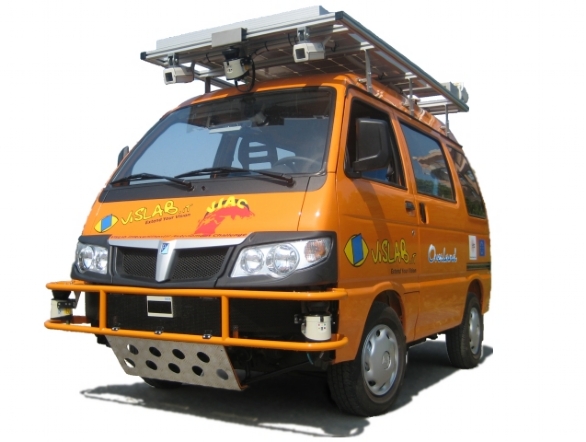Four Driverless Robotic Vans Cross Asia--and Even Pick up Hitchhikers
www.VUE DES ISLES.com :: UK & World News,Business & Sports Latest :: Current World & UK Affairs :: Old Bits & Bobs
Page 1 of 1
 Four Driverless Robotic Vans Cross Asia--and Even Pick up Hitchhikers
Four Driverless Robotic Vans Cross Asia--and Even Pick up Hitchhikers
By PCWorld

Last month, Google surprised us when it demonstrated that current automation technology is reliable enough to drive a car for you. Even more impressive is that not one, not two, but four robotic vans using technology similar to Google’s have crossed from Italy to Shanghai, China, all completing the 8,000-mile trek without drivers just in time for Shanghai Expo.
Researchers from the VisLab at the University of Parma in Italy have designed solar-powered unmanned vehicles that can autonomously operate and drive on all sorts of roads and in a variety of conditions with current off-the-shelf technology. VisLab has worked on developing systems that use lasers, radar, and cameras to detect vehicles, lanes, slopes of hills, as well as navigation, and yes, pedestrian detection (this isn’t Grand Theft Auto). The vans also took into account weather and traffic in helping the computers select the optimal routes and the best ways to drive them.
While using solar panels meant that the vans didn’t have to rely on gasoline for fuel, they did have to charge for eight hours to drive for three. This made for one long road trip of exactly three months from start to finish, especially for the backup humans on board the vans in case of emergency, but as the vans went less than 40 mph, the passengers spent a lot of time just watching the countryside slip past through the windows.
At one point, a van even offered a lift to a hitchhiker. In Russia, the vans entered a pedestrian zone, and the local police officer came to write tickets for the drivers... who weren’t there! In an episode of what could have been the first ticket given to an autonomous vehicle, the onboard engineers managed to talk the officers out of giving tickets. The vans also drove at night, dealt with toll booths, and managed to mostly avoid accidents.
Will we be seeing more robotic cars that can travel without drivers? Probably, but my guess is that they’ll be slow to be adopted, especially with low top speeds (though would that make them safer in case of a collision?). Passenger cars could probably benefit from the collision- and pedestrian-avoidance technology, as well as improved electric technology

Last month, Google surprised us when it demonstrated that current automation technology is reliable enough to drive a car for you. Even more impressive is that not one, not two, but four robotic vans using technology similar to Google’s have crossed from Italy to Shanghai, China, all completing the 8,000-mile trek without drivers just in time for Shanghai Expo.
Researchers from the VisLab at the University of Parma in Italy have designed solar-powered unmanned vehicles that can autonomously operate and drive on all sorts of roads and in a variety of conditions with current off-the-shelf technology. VisLab has worked on developing systems that use lasers, radar, and cameras to detect vehicles, lanes, slopes of hills, as well as navigation, and yes, pedestrian detection (this isn’t Grand Theft Auto). The vans also took into account weather and traffic in helping the computers select the optimal routes and the best ways to drive them.
While using solar panels meant that the vans didn’t have to rely on gasoline for fuel, they did have to charge for eight hours to drive for three. This made for one long road trip of exactly three months from start to finish, especially for the backup humans on board the vans in case of emergency, but as the vans went less than 40 mph, the passengers spent a lot of time just watching the countryside slip past through the windows.
At one point, a van even offered a lift to a hitchhiker. In Russia, the vans entered a pedestrian zone, and the local police officer came to write tickets for the drivers... who weren’t there! In an episode of what could have been the first ticket given to an autonomous vehicle, the onboard engineers managed to talk the officers out of giving tickets. The vans also drove at night, dealt with toll booths, and managed to mostly avoid accidents.
Will we be seeing more robotic cars that can travel without drivers? Probably, but my guess is that they’ll be slow to be adopted, especially with low top speeds (though would that make them safer in case of a collision?). Passenger cars could probably benefit from the collision- and pedestrian-avoidance technology, as well as improved electric technology
 Similar topics
Similar topics» Roadside snack vans threatened unless they offer healthy food .
» One in ten 'would pick TV over partner'
» ouch..... this is gonna pick for a bit!!
» Grand National - Pick your Winner
» Jesus did not die on cross, says scholar
» One in ten 'would pick TV over partner'
» ouch..... this is gonna pick for a bit!!
» Grand National - Pick your Winner
» Jesus did not die on cross, says scholar
www.VUE DES ISLES.com :: UK & World News,Business & Sports Latest :: Current World & UK Affairs :: Old Bits & Bobs
Page 1 of 1
Permissions in this forum:
You cannot reply to topics in this forum


